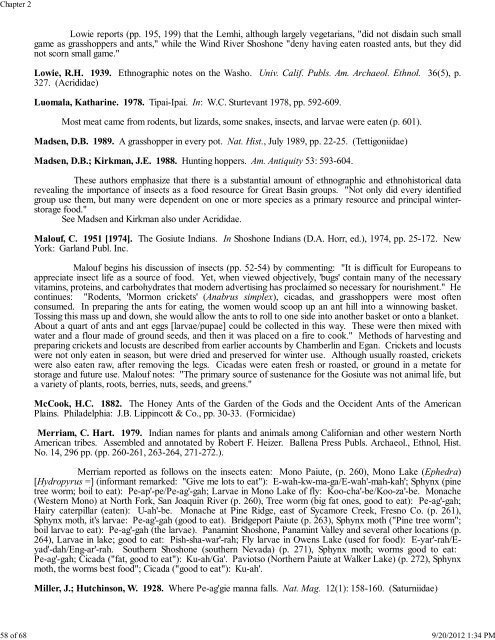Chapter 2. Insect Foods of North American Indigenous Populations ...
Chapter 2. Insect Foods of North American Indigenous Populations ...
Chapter 2. Insect Foods of North American Indigenous Populations ...
You also want an ePaper? Increase the reach of your titles
YUMPU automatically turns print PDFs into web optimized ePapers that Google loves.
<strong>Chapter</strong> 258 <strong>of</strong> 68 9/20/2012 1:34 PMLowie reports (pp. 195, 199) that the Lemhi, although largely vegetarians, "did not disdain such smallgame as grasshoppers and ants," while the Wind River Shoshone "deny having eaten roasted ants, but they didnot scorn small game."Lowie, R.H. 1939. Ethnographic notes on the Washo. Univ. Calif. Publs. Am. Archaeol. Ethnol. 36(5), p.327. (Acrididae)Luomala, Katharine. 1978. Tipai-Ipai. In: W.C. Sturtevant 1978, pp. 592-609.Most meat came from rodents, but lizards, some snakes, insects, and larvae were eaten (p. 601).Madsen, D.B. 1989. A grasshopper in every pot. Nat. Hist., July 1989, pp. 22-25. (Tettigoniidae)Madsen, D.B.; Kirkman, J.E. 1988. Hunting hoppers. Am. Antiquity 53: 593-604.These authors emphasize that there is a substantial amount <strong>of</strong> ethnographic and ethnohistorical datarevealing the importance <strong>of</strong> insects as a food resource for Great Basin groups. "Not only did every identifiedgroup use them, but many were dependent on one or more species as a primary resource and principal winterstoragefood."See Madsen and Kirkman also under Acrididae.Malouf, C. 1951 [1974]. The Gosiute Indians. In Shoshone Indians (D.A. Horr, ed.), 1974, pp. 25-17<strong>2.</strong> NewYork: Garland Publ. Inc.Malouf begins his discussion <strong>of</strong> insects (pp. 52-54) by commenting: "It is difficult for Europeans toappreciate insect life as a source <strong>of</strong> food. Yet, when viewed objectively, 'bugs' contain many <strong>of</strong> the necessaryvitamins, proteins, and carbohydrates that modern advertising has proclaimed so necessary for nourishment." Hecontinues: "Rodents, 'Mormon crickets' (Anabrus simplex), cicadas, and grasshoppers were most <strong>of</strong>tenconsumed. In preparing the ants for eating, the women would scoop up an ant hill into a winnowing basket.Tossing this mass up and down, she would allow the ants to roll to one side into another basket or onto a blanket.About a quart <strong>of</strong> ants and ant eggs [larvae/pupae] could be collected in this way. These were then mixed withwater and a flour made <strong>of</strong> ground seeds, and then it was placed on a fire to cook." Methods <strong>of</strong> harvesting andpreparing crickets and locusts are described from earlier accounts by Chamberlin and Egan. Crickets and locustswere not only eaten in season, but were dried and preserved for winter use. Although usually roasted, cricketswere also eaten raw, after removing the legs. Cicadas were eaten fresh or roasted, or ground in a metate forstorage and future use. Malouf notes: "The primary source <strong>of</strong> sustenance for the Gosiute was not animal life, buta variety <strong>of</strong> plants, roots, berries, nuts, seeds, and greens."McCook, H.C. 188<strong>2.</strong> The Honey Ants <strong>of</strong> the Garden <strong>of</strong> the Gods and the Occident Ants <strong>of</strong> the <strong>American</strong>Plains. Philadelphia: J.B. Lippincott & Co., pp. 30-33. (Formicidae)Merriam, C. Hart. 1979. Indian names for plants and animals among Californian and other western <strong>North</strong><strong>American</strong> tribes. Assembled and annotated by Robert F. Heizer. Ballena Press Publs. Archaeol., Ethnol, Hist.No. 14, 296 pp. (pp. 260-261, 263-264, 271-27<strong>2.</strong>).Merriam reported as follows on the insects eaten: Mono Paiute, (p. 260), Mono Lake (Ephedra)[Hydropyrus =] (informant remarked: "Give me lots to eat"): E-wah-kw-ma-ga/E-wah'-mah-kah'; Sphynx (pinetree worm; boil to eat): Pe-ap'-pe/Pe-ag'-gah; Larvae in Mono Lake <strong>of</strong> fly: Koo-cha'-be/Koo-za'-be. Monache(Western Mono) at <strong>North</strong> Fork, San Joaquin River (p. 260), Tree worm (big fat ones, good to eat): Pe-ag'-gah;Hairy caterpillar (eaten): U-ah'-be. Monache at Pine Ridge, east <strong>of</strong> Sycamore Creek, Fresno Co. (p. 261),Sphynx moth, it's larvae: Pe-ag'-gah (good to eat). Bridgeport Paiute (p. 263), Sphynx moth ("Pine tree worm";boil larvae to eat): Pe-ag'-gah (the larvae). Panamint Shoshone, Panamint Valley and several other locations (p.264), Larvae in lake; good to eat: Pish-sha-war'-rah; Fly larvae in Owens Lake (used for food): E-yar'-rah/Eyad'-dah/Eng-ar'-rah.Southern Shoshone (southern Nevada) (p. 271), Sphynx moth; worms good to eat:Pe-ag'-gah; Cicada ("fat, good to eat"): Ku-ah/Ga'. Paviotso (<strong>North</strong>ern Paiute at Walker Lake) (p. 272), Sphynxmoth, the worms best food"; Cicada ("good to eat"): Ku-ah'.Miller, J.; Hutchinson, W. 1928. Where Pe-ag'gie manna falls. Nat. Mag. 12(1): 158-160. (Saturniidae)
















